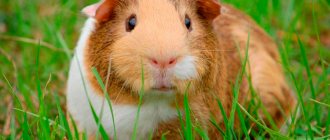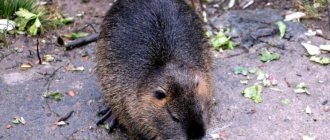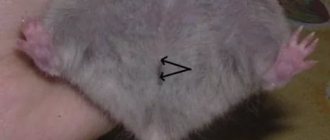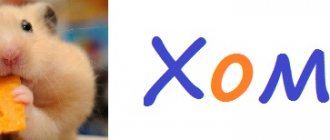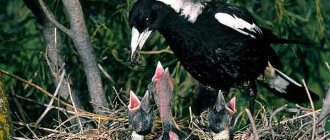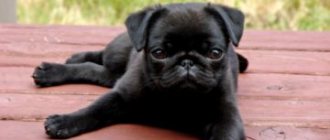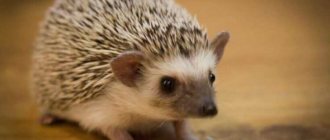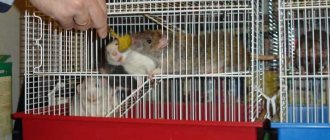- Wild animals
- >>
- Mammals
Nutria , the swamp beaver, is a rodent that leads a semi-aquatic lifestyle. This mammal has interesting habits and is a valuable fishery object. Farmers are actively breeding these animals, since their meat and fur are highly valued on the market. What are nutria, what are their habits and how do they reproduce?
Description of the rodent
— Advertising —
In terms of its external characteristics, nutria is similar to a large rat. The rodent's body length is up to 60 cm, its tail is about 45 cm long, and the weight of nutria is from 5 to 12 kg. Males are usually larger than females.
The body is heavy with a massive head, small eyes and ears. The legs are quite short. The muzzle is blunt, with long vibrissae. The incisors are bright orange.
The semi-aquatic lifestyle determined some of the anatomical features of this species. Thus, the nasal openings of nutria have special obturator muscles and close tightly when necessary. The lips in front are separated and close tightly behind the incisors, this allows the animal to gnaw plants under water and not let water into the mouth during this. There are membranes between the toes of the hind legs. The tail is round in shape, without hair, its surface is covered with scaly skin; when swimming, the nutria's tail serves as a rudder. 4-5 pairs of mammary glands and nipples are located high on the sides of female nutria, thanks to which babies can receive food even in water.
In addition, nutria have waterproof fur, which consists of long, coarse awns and a thick, curled brown undercoat. On the sides the coat is lighter and has a yellow tint. On the tummy and sides it is thicker than on the back, in order to better retain heat on the lower part of the body. Molting in adults occurs gradually throughout the year. It slows down somewhat only in mid-summer (July to August) and winter (November to March). Nutria have the best fur from November to March.
Treatment and prevention of diseases
Nutria are characterized by immunity to many diseases. However, failure to follow the rules of care may cause:
Ringworm
The disease can be identified by signs such as hair loss and the formation of itchy scabs on the surface of the skin. If alarming symptoms appear, the affected areas are treated with an antiseptic and antifungal therapy is administered. The cage of a sick animal is also disinfected.
Salmonellosis
The development of this disease is indicated by loss of appetite, weight loss, diarrhea and tearing. At an early stage, the disease can be treated with antibiotics, but at a late stage the animal will have to be slaughtered.
Pasteurellosis
The main symptoms of this disease are lethargy, lack of appetite, later convulsions and paralysis. Pasteurellosis cannot be treated, so sick animals are slaughtered and the cages are disinfected.
Helminthiasis
When infected with parasites, animals lose weight. The disease is treated with anthelmintic drugs.
Any disease is easier to prevent than to cure. The following will help you avoid trouble:
- hygiene of premises and utensils;
- using only clean water and high-quality feed;
- regular inspection of nutria for diseases and immediate isolation of sick individuals.
Nutritional features of nutria
— Advertising —
Nutria is primarily a herbivore. It feeds on rhizomes, stems, leaves of reeds and cattails. The rodent's diet also includes reeds, water chestnuts, water lilies, and pondweeds. Occasionally, nutria also eats animal food (leeches, mollusks), but only in cases where there is a lack of plant food.
Animal health
These animals are very unpretentious and resistant to various types of diseases and infections.
The most important thing is to avoid excessive dampness and drafts. And provide adequate nutrition and access to walking.
It is also important to clean the bedding so that there are no parasites that can spoil the fur and skin of the animal.
The main treatment is treatment with antiparasitic agents and thorough cleaning of the room where the nutria live.
Nutria distribution
The natural habitat of nutria includes the southern part of South America, ranging from Bolivia and southern Brazil all the way to Tierra del Fuego. Later, the animal was introduced and took root in many countries of Europe, Asia, and North America. But in Africa, nutria did not acclimatize. Found in Transcaucasia, Kyrgyzstan and Tajikistan. Depending on climatic conditions in winter, the distribution of nutria varies. For example, in the 1980s, very cold winters led to the complete disappearance of nutria in Scandinavia and the northern United States.
Keeping an animal at home
Such large animals are kept at home, pursuing the main financial goals - the sale of meat and valuable skins. In this case, the required conditions for keeping nutria must be observed. Up to 8 young individuals are placed in an enclosure. Females and children are taken to separate housing.
The cage or enclosure should be located away from noisy sources. Living in an enclosure, the animal feels more comfortable because it has a walking area and a swimming area.
When keeping nutria at home, it is better to transfer it to the wild in the summer. Basically, cell dwellers do not have a home pond for swimming. Some breeders raise their pets in basements where there is electric lighting.
Swamp animals need large amounts of drinking water, especially in the summer. It is not recommended to limit water intake for pregnant females.
Note!
- How to protect a gazebo from rain and wind in summer and snow in winter - a review of the best options
Chicken - description, types, classification, nutrition and maintenance of domestic chicken (115 photos and videos)
Fretka - lifestyle, care and character traits. 115 photos and videos tips for keeping a pet ferret
Nutria practically does not drink during the cold season. During this time, she burrows into the litter, receiving moisture from natural vegetables. Nutria do not have a specific odor. However, care and cleaning for them is still necessary. Keeping nutria at home requires monitoring the availability of water and food in the cages.
Common types of nutria
Nutria is the only species of its genus, and all its varieties are divided into two types:
- standard breeds with brown fur, hairs dark at the roots and lighter at the tips;
- breeds with other color options:
Golden nutria
They are distinguished by beautiful, as if “gilded” fur. The richest color is on the back, along the line of the spine. The abdomen is soft pinkish. The breed is characterized by low fertility, with up to 3 cubs in one litter.
Black nutria
They have black velvety fur. Their skin is thick, dark, rich. The number of babies in one brood is the same as that of an ordinary nutria.
Pearl nutria
Obtained by crossing “snow”, “lemon” and “pastel” breeds, the color tone of the skin is similar to the color of pearls. The belly is light, becoming darker closer to the back.
Lemon nutria
Bred by crossing “Italian” and “beige” nutria breeds, it is distinguished by delicate, slightly orange, lemon-tinged fur.
Snow Nutria
Obtained by crossing “golden” and “silver” nutria, it has pure white fur. The rodent's legs, tail and nose are colored a warm pinkish color.
Silver nutria
Dyed in a dark color similar to silver, it is widely used in the production of fur products. There are various shades, light and dark, as well as bluish.
Brown nutria
Bred by crossing black and golden breeds.
Azerbaijani white
In the USSR, breeders, having received nutria in the 30s. last century, they immediately began to breed animals with white fur. But all the animals they received were albinos who could not have viable offspring. Rebreeding began in the mid-20th century. Then we managed to remove nutria with white spots on the head. But real white nutria were bred in Azerbaijan - in 1956. This breed had everything white - both the guard hairs and the underfur.
Description. White animals have a dense build. They have a thick neck that smoothly merges into the body. Near the eyes, mouth and ears there is a border that is slightly darker than the main color. The webbed feet are pinkish. The eyes are the color of coffee.
Productivity and properties of fur. Normal weight is 5-7 kg. Fertility is average - there are from 4 to 5 cubs in the litter. If two Azerbaijani nutrias are mated, then the litter may contain white and standard-colored animals, but there are still more white ones. The breed is distinguished by very high taste characteristics of meat - it is as nutritious as rabbit meat, but tastier.
Features of the breed. Natural coloring is transmitted by dominant genes. The advantage of this breed is the same structure of down and outer hair. Thanks to this, the hair and underfur are indistinguishable from each other, and the fur of Azerbaijani nutria is especially highly valued.
The quality of fur depends on the nutrition and living conditions. The animals need an artificial pond in which lush grass can grow. The quality of the fur will be poor, both with malnutrition and with overnutrition.
Nutria behavior
Nutria have a semi-aquatic lifestyle. The animal lives in reservoirs with weakly flowing or stagnant water, along swampy river banks, near reed-cattail lakes and alder-sedge swamps, where aquatic and coastal vegetation grows, on which they feed. Nutria can swim and dive well. They stay under water for up to 10 minutes. They hide in the shade from the heat.
Nutria avoids continuous forests and is not found in the mountains above 1200 m above sea level. Nutria normally tolerates frosts down to -35° C, but in general it is not adapted for life in cold climates. This is due to the fact that the animal does not build reliable shelters from the cold and predators, and does not store food for the winter, unlike a beaver or muskrat. In addition, nutria has poor orientation under the ice; when diving into an ice hole, it cannot find a way out and dies.
Under natural conditions, nutria are active at night.
Nutria are semi-nomadic rodents; when there is plenty of food and shelter, they do not move far. They breed offspring and rest in open nests, which are built on hummocks and in thickets of reeds and cattails, from their stems. Along steep banks, nutria dig burrows, both simple tunnels and complex systems of passages. You can find them along paths trampled by rodents in the surrounding vegetation. Nutria usually live in groups of 2-13 individuals, which include adult females, offspring and a male. Young males live alone.
Nutria have well-developed hearing; the animal runs quickly and spasmodically. Vision and sense of smell are poorly developed.
Cream
These animals were identified as a separate group due to their unique coloration.
Description. The color of the fur is uneven. The back is beige or brown. The belly is lighter - soft beige shades. The skin of the nose is brown, the paws are bluish-pink.
Productivity and properties of fur. They value the fur of six-month-old animals. If the fur gets old, it becomes covered with a yellow or brownish coating and is of no value. There are 4-5 puppies in the litter.
Features of the breed. The most beautiful color of the skin acquires at 4-5 months of the animal’s life. The fur then darkens or becomes yellowish. To get cream babies, you need to cross cream individuals with each other. If you cross a beige animal with a “standard” one, the offspring will be brown.
Nutria reproduction
Nutria can reproduce throughout the year and are prolific animals. The periods of highest sexual activity in males are repeated every 25-30 days. The female usually breeds 2-3 litters per year, up to 10 cubs each, in spring and summer. Pregnancy lasts from 127 to 132 days. Intensive growth of young nutria continues until the age of 5-6 months. At 3-4 years, nutria fertility decreases
The average lifespan of nutria is 6-8 years.
Breeding
It is best to mate an animal starting from 8 months. One male can serve up to 15 females. It is possible to determine whether a female is pregnant only after a month and a half. Holding the nutria by the tail with one hand, you can feel the small balls in its stomach.
Fertilized females should be moved to another cage, where there is a swimming pool and a walking area. Breeding nutria should be carried out following all the rules.
Gestation continues for 4-5 months. Then fish oil should be added to the nutria’s food. Before the birth process, nutria does not eat anything. The birth itself lasts about half an hour, in rare cases it drags on for longer.
Born animals begin their movements immediately after birth. The weight of a newborn is approximately 200 g. Already on the third day after birth, the calves eat adult food and are able to swim in the pool.
In a situation where the female does not feed her cubs and behaves restlessly, it is better to move her to the male for a certain period of time. The nutria and its cubs are placed in a warm, comfortable enclosure. Rodents continue to grow actively for 2 years.
Interesting facts about the rodent:
- Nutria is an object of fishing and breeding. The animals are kept in cages consisting of a special house with a walk and a swimming pool. Semi-free housing in enclosures and free-range housing are also used. On farms, nutria are bred in both the standard brown color and colored ones, white, black, pink, beige, and golden. The skin is slaughtered at the age of 8-9 months. The fur with the long axis has the greatest value. Nutria is also bred for meat. It tastes good and is recognized as a dietary product. In addition, nutria are tamed and kept as pets.
- The first nutria breeding farms were founded at the end of the 19th and beginning of the 20th centuries in Argentina. A little later, these rodents were introduced to the USA, Europe and Asia. Also, acclimatization of nutria was successfully carried out in the Transcaucasus, Georgia, and Tajikistan.
- In some countries, wild nutria are recognized as pests, as they eat aquatic vegetation, damage irrigation systems, dams, and undermine river banks.
The fashion industry is against real fur
When calculating the profitability of a farm today, one should not underestimate such new fashion trends as the refusal to use natural fur.
Fashion houses with big names are abandoning it, world-famous stars no longer wear it, and some countries completely ban its production and sale. A living animal is better than a dead one. It's worth thinking about, isn't it?
The healing properties of fat
Nutrium fat is recommended as an easily digestible, non-refractory product that is not capable of causing harm to the human body. It is even recommended to be consumed by people suffering from hypertension.
- For medicinal purposes it is used for:
- colds (to get rid of a runny nose, it is enough to lubricate the nostrils for 2 days);
- bronchitis and pneumonia (due to the property of improving blood circulation and thinning mucus, it is recommended to lubricate the chest and the area between the shoulder blades with massage movements, then wrap yourself in a warm blanket);
- sore throat (warm compresses are effective);
- deep, poorly healing wounds, heel cracks (used externally).
Natural enemies
Since nutria are not predators, they quite often become prey for fauna that prefer animal food.
In the wild, these rodents are hunted by:
- Poisonous snakes;
- alligators;
- wolves;
- jaguars;
- cougars;
- predator birds.
Feeling their vulnerability in the external environment, swamp beavers always prefer to be near bodies of water. If the possibility of escape by flight is limited, the mammal goes on the offensive.
In such fights, his reliable weapon is his sharp front incisors, the growth of which does not stop throughout his life. With them, the animal bites tightly into the offender, regardless of his size and capabilities.
Did you know? Nutria found the best living conditions in the American state of Louisiana, and there they became a real disaster. Over the past 13 years, several animals that have escaped to freedom have bred up to 2 million individuals.
Owner reviews
Everyone who keeps swamp beavers notes their extreme unpretentiousness, cleanliness and omnivorousness.
They eat almost everything that grows in the surrounding area, but they especially love zucchini, apples, cabbage, carrots, sorrel and even watermelon rinds. The only thing that should not be given to nutria is sweet beets: for some reason rodents are poisoned by it and even die.
The animals, according to observers, eat porridge with mixed feed in an extremely hilarious way: they break off pieces with their paws, covering their eyes and groaning with pleasure when they put the porridge into their mouths.
Important! Animals get sick very rarely, but this does not relieve the owner of the responsibility to vaccinate them on time and keep the enclosure clean.
Often, nutria (with its tasty and rather expensive meat, as well as valuable fur) turns from a hobby into the main and significant source of income not only for one person, but also for the whole family.
Return to content
The specific name of the family is translated as “mouse-beaver”.
2. Nutria is also known as coipu and swamp beaver.
3. Nutria is native to South America. If translated from Spanish, nutria is an otter. Nutria is often called a swamp rat.
4. Nutria represents the beaver rat family. But in no case does it apply to them. Rather, in terms of kinship it can be compared to a guinea pig. And the confusion occurs because the nutria’s lifestyle is the same as that of the beaver.
5. Nutria were brought to Russia during the Soviet era in 1930 from Argentina.
6. Nutria is a large rodent. The average weight of an adult nutria is 5-7 kilograms, sometimes 9-10 kilograms. The length of the body from the muzzle to the root of the tail is 45-60 centimeters, the circumference of the chest behind the shoulder blades is 29-46 centimeters. There are membranes between the toes of the hind legs. The tail is covered with scales and sparse coarse hair: the length of the tail is 25-35 centimeters. Nutria fur is as durable as fox or mink fur.
7. Nutria’s ears are short, slightly pubescent on the outside; The inside of the ears is covered with fluffy hair, which traps air and prevents water from penetrating into the ear canal.
8. The eyes of nutria are located at the level of the surface of the forehead, which provides a swimming animal with a good view. The nostrils have obturator muscles that contract when diving. On the upper lip and cheeks there are thick vibrissae hairs that act as organs of touch.
9. Nutria has 20 teeth. The incisors are especially well developed, 2 in each jaw. The incisors protrude forward; in healthy nutria they are bright orange, and in young and old sick animals they are light or with dark spots. Incisors grow continuously as they are worn down or broken.
10. The nutria stomach is single-chamber, its volume reaches 500 cubic centimeters. The intestine is 10-12 times longer than the body. The residence time of the main part of the food in the gastrointestinal tract of young animals is 24-30 hours, and in adult nutrias it is 60-70 hours.
11.The hair on the abdomen is much thicker than on the back. Shedding continues throughout the year—there is hair falling out at any time. The quality of the skins is somewhat better in the cold season.
12. The natural habitat of nutria includes the southern part of South America, ranging from Bolivia and southern Brazil to Tierra del Fuego.
13.Later, this animal was introduced and took root in many countries of Europe, Asia, and North America. But in Africa, nutria did not acclimatize.
14.It is also found in Transcaucasia, Kyrgyzstan and Tajikistan.
15. Depending on climatic conditions in winter, the distribution of nutria changes. For example, in the 1980s, very cold winters led to the complete disappearance of nutria in Scandinavia and the northern United States.
16. Nutria is the only species of its genus, and all its varieties are divided into two types: standard breeds with brown fur, hairs dark at the roots and lighter at the tips; breeds with other color options.
17. Nutria leads a semi-aquatic lifestyle. The animal lives in reservoirs with weakly flowing or standing water, along swampy river banks, near reed-cattail lakes and alder-sedge swamps, where aquatic and coastal vegetation grows, on which they feed.
18. Nutria can swim and dive well. They stay under water for up to 10 minutes. They hide in the shade from the heat.
19. Nutria avoids continuous forests; it is not found in the mountains above 1200 meters above sea level. Nutria normally tolerates frosts down to -35° C, but in general it is not adapted for life in cold climates.
20. This animal does not build reliable shelters from the cold and predators, and does not store food for the winter, unlike a beaver or muskrat. In addition, nutria has poor orientation under the ice; when diving into an ice hole, it cannot find a way out and dies.
BLACK NUTRIA
21. Black nutria have black velvety fur. Their skin is thick, dark, rich. The number of babies in one brood is the same as that of an ordinary nutria.
22. Nutria is primarily a herbivore. It feeds on rhizomes, stems, leaves of reeds and cattails. The rodent's diet also includes reeds, water chestnuts, water lilies, and pondweeds.
23.Occasionally, nutria also eats animal food (leeches, mollusks), but only in cases where there is not enough plant food.
24. Nutria have well-developed hearing, the animal runs quickly and spasmodically. Vision and smell are poorly developed.
25. Nutria can become prey for predators, but in general their population is stable and not under threat.
GOLDEN NUTRIA
26. Golden nutria are distinguished by beautiful, as if “gilded” fur. The richest color is on the back, along the line of the spine. The abdomen is soft pinkish. The breed is characterized by low fertility, with up to 3 cubs in one litter.
27. Nutria can reproduce throughout the year and are fertile animals. The periods of highest sexual activity in males are repeated every 25-30 days.
28. The female usually breeds 2-3 litters per year, up to 10 cubs each, in spring and summer. Pregnancy lasts from 127 to 132 days.
29.4-5 pairs of mammary glands and nipples are located high on the sides of female nutria, thanks to which babies can receive food even in water.
30.Intensive growth of young nutria continues until the age of 5-6 months. At 3-4 years, nutria fertility decreases
31. In nutria, sexual dimorphism is manifested in the fact that males are larger in size than females.
32. Under natural conditions, nutria is active at night.
SILVER NUTRIA
33. Silver nutria are dark colored, similar to the color of silver, and are widely used in the production of fur products. There are various shades, light and dark, as well as bluish.
34. Nutria are semi-nomadic rodents; if there is enough food and shelter, they do not move far. They breed offspring and rest in open nests, which are built on hummocks and in thickets of reeds and cattails, from their stems.
35. Nutria digs burrows along steep banks, both simple tunnels and complex systems of passages. You can find them along paths trampled by rodents in the surrounding vegetation.
36. Nutria usually live in groups of 2-13 individuals, which include adult females, offspring and a male. Young males live alone.
SNOW NUTRIA
37. Snow nutria are obtained by crossing “golden” and “silver” nutria and have pure white fur. The rodent's legs, tail and nose are colored a warm pinkish color.
38. The average lifespan of nutria is 6-8 years.
LEMON NUTRIAS
39. Lemon nutria were bred by crossing “Italian” and “beige” nutria breeds; they are distinguished by delicate, slightly orange fur with a lemon tint.
40. Nutria is an object of fishing and breeding. The animals are kept in cages consisting of a special house with a walk and a swimming pool. They also use semi-free housing in enclosures and free-range housing.
41. Nutria are bred on farms, both the standard brown color and colored ones, white, black, pink, beige, and golden. They are slaughtered for skinning at the age of 8-9 months. The fur with the long axis has the greatest value.
42. Nutria is also bred for the purpose of producing meat. It tastes good and is recognized as a dietary product. In addition, nutria are tamed and kept as pets.
43.The first nutria breeding farms were founded at the end of the 19th – beginning of the 20th centuries in Argentina.
PEARL NUTRIA
44. Pearl nutria are obtained by crossing “snow”, “lemon” and “pastel” breeds; the color tone of the skin is similar to the color of pearls. The belly is light, becoming darker closer to the back.
45. In some countries, wild nutria are recognized as pests, as they eat aquatic vegetation, damage irrigation systems, dams and undermine river banks.
BROWN NUTRIA
46. Brown nutria were bred by crossing black and golden breeds.
47. In their natural environment, nutria live along the banks of shallow and non-freezing reservoirs.
48. Nutria does not store food reserves for the winter; it feeds on aquatic and coastal plants (reeds, cattails, reeds, etc.) all year round, eating primarily rhizomes, tubers, and fruits.
49.With a lack of succulent plant food, nutria consumes small quantities of leaves of trees, shrubs and the bark of young branches.
50. Nutria is not adapted to living in frozen bodies of water. She dives and swims deftly, but does not navigate the water under the ice and does not tolerate cold and drafts well.
photo from the Internet
Meat value
Nutria meat tastes much like pork, but differs favorably from it in its “lightness” and beneficial properties.
With a calorie content of 149 kilocalories per 100 g of product, the nutritional value is as follows:
| squirrels | 23.92 g |
| fats | 4.72 g |
| carbohydrates | 1.01 g |
| water | 70.82 g |
| ash | 0.98 g |
It contains (per 100 g):
| thiamine | 0.058 mg | ||||||
| tocopherol | 0.95 mg | ||||||
| folacin | 12.51 mg | ||||||
| biotin | 0.009 mcg | ||||||
| pantothenic acid | 0.44 mg | ||||||
| retinol | 0.06 mg | ||||||
| riboflavin | 0.21 mg | ||||||
| ascorbic acid | 1.97 mg | ||||||
| choline | 125.1 mg | ||||||
| cobalamin | 7.81 mcg | ||||||
| niacin | 1.85 mg | ||||||
| iron | 6.8 mg | ||||||
| potassium | 347.7 mg | ||||||
| calcium | 14.89 mg8 | ||||||
| cobalt | 14.88 mcg | ||||||
| magnesium | 24.79 mg | ||||||
| manganese | 26 mcg | ||||||
| copper | 151 mcg | ||||||
| sodium | 50.8 mg | ||||||
| zinc | 2.5 mg | ||||||
| iodine | 5.3 mcg | phosphorus | 236.8 mg | fluorine | 103.4 mcg | selenium | 26.5 mcg |
People who regularly eat nutria meat have noticed positive changes in their bodies.
- This easily digestible delicacy is believed to have the following health benefits:
- strengthens the immune system (recommended by nutritionists after grueling physical activity and long-term illnesses);
- nourishes the body, providing the necessary proteins, vitamins and microelements for obesity (helps to lose extra pounds);
- increases vitality (helps cope with drowsiness, insomnia);
- improves the condition of hair, nails and skin;
- stimulates the production of thyroid hormones (recommended for thyroid dysfunction);
- activates metabolism;
- improves the blood formula (for anemia).
Important! Nutrium meat is strictly contraindicated for people with individual intolerance. In all other cases, it should be consumed only after careful heat treatment, since this is a favorable environment for the proliferation of Trichinella.
